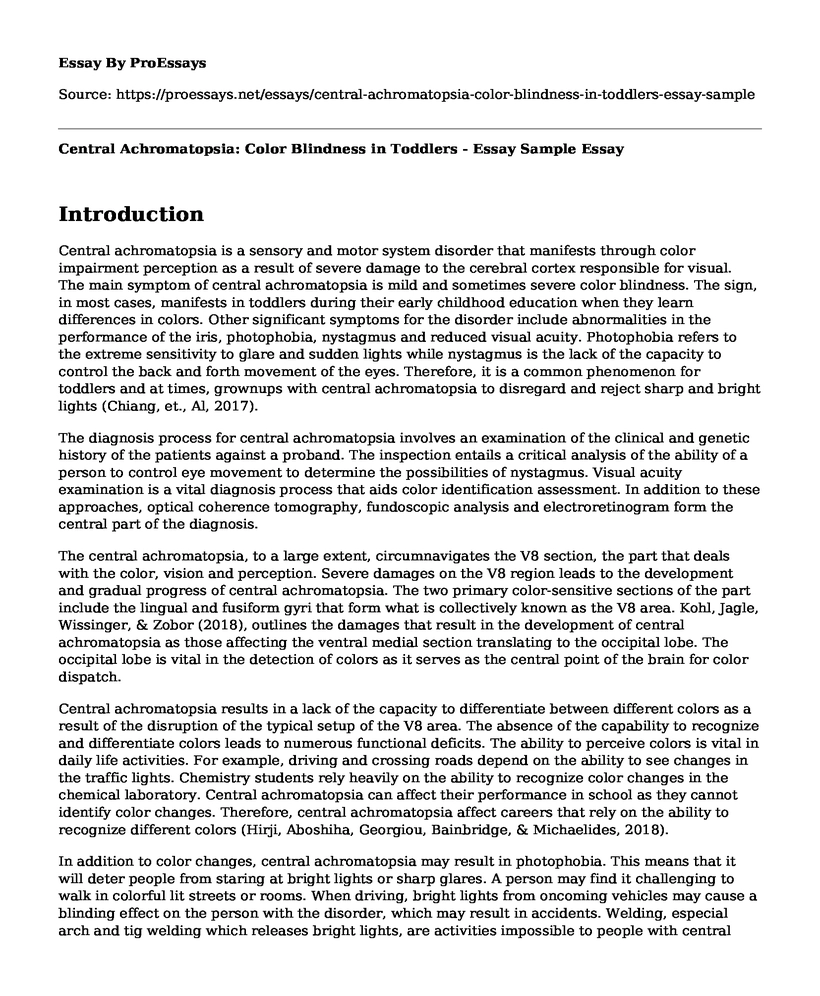Introduction
Central achromatopsia is a sensory and motor system disorder that manifests through color impairment perception as a result of severe damage to the cerebral cortex responsible for visual. The main symptom of central achromatopsia is mild and sometimes severe color blindness. The sign, in most cases, manifests in toddlers during their early childhood education when they learn differences in colors. Other significant symptoms for the disorder include abnormalities in the performance of the iris, photophobia, nystagmus and reduced visual acuity. Photophobia refers to the extreme sensitivity to glare and sudden lights while nystagmus is the lack of the capacity to control the back and forth movement of the eyes. Therefore, it is a common phenomenon for toddlers and at times, grownups with central achromatopsia to disregard and reject sharp and bright lights (Chiang, et., Al, 2017).
The diagnosis process for central achromatopsia involves an examination of the clinical and genetic history of the patients against a proband. The inspection entails a critical analysis of the ability of a person to control eye movement to determine the possibilities of nystagmus. Visual acuity examination is a vital diagnosis process that aids color identification assessment. In addition to these approaches, optical coherence tomography, fundoscopic analysis and electroretinogram form the central part of the diagnosis.
The central achromatopsia, to a large extent, circumnavigates the V8 section, the part that deals with the color, vision and perception. Severe damages on the V8 region leads to the development and gradual progress of central achromatopsia. The two primary color-sensitive sections of the part include the lingual and fusiform gyri that form what is collectively known as the V8 area. Kohl, Jagle, Wissinger, & Zobor (2018), outlines the damages that result in the development of central achromatopsia as those affecting the ventral medial section translating to the occipital lobe. The occipital lobe is vital in the detection of colors as it serves as the central point of the brain for color dispatch.
Central achromatopsia results in a lack of the capacity to differentiate between different colors as a result of the disruption of the typical setup of the V8 area. The absence of the capability to recognize and differentiate colors leads to numerous functional deficits. The ability to perceive colors is vital in daily life activities. For example, driving and crossing roads depend on the ability to see changes in the traffic lights. Chemistry students rely heavily on the ability to recognize color changes in the chemical laboratory. Central achromatopsia can affect their performance in school as they cannot identify color changes. Therefore, central achromatopsia affect careers that rely on the ability to recognize different colors (Hirji, Aboshiha, Georgiou, Bainbridge, & Michaelides, 2018).
In addition to color changes, central achromatopsia may result in photophobia. This means that it will deter people from staring at bright lights or sharp glares. A person may find it challenging to walk in colorful lit streets or rooms. When driving, bright lights from oncoming vehicles may cause a blinding effect on the person with the disorder, which may result in accidents. Welding, especial arch and tig welding which releases bright lights, are activities impossible to people with central achromatopsia. In a more severe case, central achromatopsia can stimulate brain damage, which can ultimately render a person incapacitated.
References
Chiang, W. C., Chan, P., Wissinger, B., Vincent, A., Skorczyk-Werner, A., Krawczynski, M. R., ... & Lin, J. H. (2017). Achromatopsia mutations target sequential steps of ATF6 activation. Proceedings of the National Academy of Sciences, 114(2), 400-405.
Hirji, N., Aboshiha, J., Georgiou, M., Bainbridge, J., & Michaelides, M. (2018). Achromatopsia: clinical features, molecular genetics, animal models, and therapeutic options. Ophthalmic genetics, 39(2), 149-157.
Kohl, S., Jagle, H., Wissinger, B., & Zobor, D. (2018). Achromatopsia. In GeneReviews[Internet]. University of Washington, Seattle.
Cite this page
Central Achromatopsia: Color Blindness in Toddlers - Essay Sample. (2023, May 03). Retrieved from https://proessays.net/essays/central-achromatopsia-color-blindness-in-toddlers-essay-sample
If you are the original author of this essay and no longer wish to have it published on the ProEssays website, please click below to request its removal:
- Impact of Nurse-Patient Ratio on Healthcare Costs Essay Example
- Essay Example on 4 Challenges Nurses Face in the Workplace
- Essay on Hematologist-Family Nurse Practitioner Collaboration: A Must-Have Skill
- My Journey to Becoming a Pediatric Nurse Practitioner - Essay Sample
- Essay on Mobile Phlebotomy Service: Accommodating Patients with Disabilities and VIPs
- Paper Sample on Becoming a Psychiatric Nurse Practitioner at Walden College of Nursing
- Essay Example on Nurse Educators: Who are They & What Do They Do?







